Home
Secondments
Recruitments
Publications
Talks
Conferences
| Name of seconded researcher |
Alexander SCHIFTNER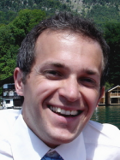 |
| Seconded from project partner |
Vienna University of Technology |
| Seconded to project partner |
RFR |
| Starting date |
2009-04-01 |
| Duration of secondment |
8 months |
| Short description |
The
secondment was focussed on
conception and implementation of a surface parametrisation / level set
curve framework, suitable for designing architectural panelisations on
freeform surfaces. This framework was built on top of existing least
squares optimisation classes. A basic graphical user interface was
implemented, exposing all available features for expert use. The most
prominent requirement for the level set framework was to allow the
placement of singularities, leading to panelisations with singular /
non-standard vertices. This is a crucial requirement for panelisations
composed of developable surface strips. Several non-linear optimisation
possibilities were added to the framework, allowing the optimization of
level set curves for equal spacing, angle constraints, conjugacy,
alignment with geodesics or prescribed directions, etc. In the
meanwhile the framework developed during the secondment was
successfully applied to numerous real world test cases, where it served
as a tool for rapid prototyping of panelisations. The following video
shows an
example. |
| Name of seconded researcher |
Pietro DEMONTIS |
| Seconded from project partner |
RFR |
| Seconded to project partner |
Vienna University of Technology |
| Starting date |
2009-11-08 |
| Duration of secondment |
2 months |
| Short description |
The aim of
this secondment was to build a glass calculation bibliography. The
available scientific literature in this domain has been collected and
partially studied. Specifically the task was to understand all the
known ways to calculate glass in engineering applications, and more
generally to understand the physical phenomena that exist in such
material and in various conditions of using. Precisely, the attention
has been focused on:
|
| Name of seconded researcher |
Nicolas LEDUC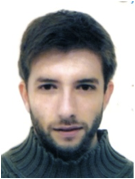 |
| Seconded from project partner |
RFR |
| Seconded to project partner |
Vienna University of Technology |
| Starting date |
2009-11-23 |
| Duration of secondment |
2 months |
| Short description |
On the
periphery of the main architectural production, a "non-standard"
architecture grew up as a counterweight. This trend is especially
sensible nowadays enhanced by the digital age. Task 1 "Market study, state of the Art" intends to collect, sort and evaluate information about this “non-standard” architecture to frame the range of the studies according to present issues but its purpose will also outline innovations for future interests. This first study is the foundation for the construction of innovative solution during the future research. Based on it, we defined the range of grid shells which are target of the study with reference to real case of application (for example: from Neumunster to British museum). |
| Name of seconded researcher |
Minh Man NGUYEN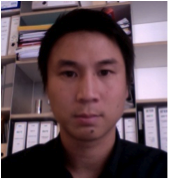 |
| Seconded from project partner |
RFR |
| Seconded to project partner |
Vienna University of Technology |
| Starting date |
2009-11-23 |
| Duration of secondment |
2 months |
| Short description |
On the
periphery of the main architectural production, a "non-standard"
architecture grew up as a counterweight. This trend is especially
sensible nowadays enhanced by the digital age. Task 1 "Market study, state of the Art" intends to collect, sort and evaluate information about this “non-standard” architecture to frame the range of the studies according to present issues but its purpose will also outline innovations for future interests. This first study is the foundation for the construction of innovative solution during the future research. Based on it, we defined the range of grid shells which are target of the study with reference to real case of application (for example: from Neumunster to British museum). |
| Name of seconded researcher |
Raphaël ROYER DE VERICOURT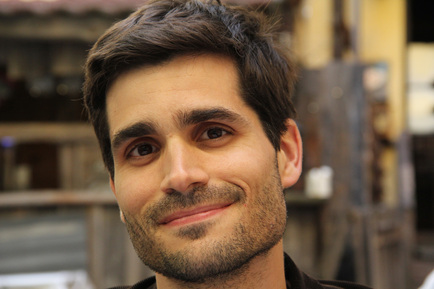
|
| Seconded from project partner |
RFR |
| Seconded to project partner |
Vienna University of Technology |
| Starting date |
2009-12-01 |
| Duration of secondment |
3 months |
| Short description |
As part of
the Work Package 5 Task 2, this secondment aimed to determine the
stress induced into a D-strip during the fabrication process. The first part of the work was a bibliographical research on the theoretical behavior of plates under large deflections; simplified equations linking the forces and stresses in the plate to the imposed developable geometry were gathered and adapted to the D-strip case. In the second part of the secondment, numerical simulations were carried out on finite element models in order to validate the theoretical predictions. Developable shapes were imposed on plate models; various shapes were studied, including cylinders and cones formed from initially flat or curved plates. Numerical results for stress and curvature were extracted from the models and compared to the values predicted by the theoretical formulas, in order to estimate the accuracy of the prediction. An example of studied model is shown below, with dimensions and loading conditions similar to glass building panels.  |
| Name of seconded researcher |
Niccolo BALDASSINI |
| Seconded from project partner |
RFR |
| Seconded to project partner |
Vienna University of Technology |
| Starting date |
2010-02-01 |
| Duration of secondment |
2 months |
| Short description |
The
secondment goal is the management of the various tasks of WP5, 6 and 7,
and their consistency as part of a global project. The involvement
particularly concerns support for the engineering parts of WP5, as well
as information gathering for future publications. General goals of the secondment:
|
| Name of seconded researcher |
Jacques RAYNAUD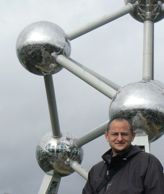 |
| Seconded from project partner |
RFR |
| Seconded to project partner |
Vienna University of Technology |
| Starting date |
2010-02-01 |
| Duration of secondment |
2 months |
| Short description |
The
secondment was mostly based on short period of one or two weeks each
time given being a MER (More Experienced Researcher) with the
particular role of coordinating the research project for the RFR team.
Overall the secondment covered a period of 36 month corresponding to
the principal task of WP5, the effective period of the secondment is 2
months. The secondment at TUW was mainly due for the general coordination of the project, and attendance of the coordination meetings. It was also necessary to supervise specific task and work which required a particular technical input to support the secondee. The secondment was also dues to run exchange session with TUW, Evolute and the RFR seconded people in Vienna in order to enhance communication and knowledge transfer. |
| Name of seconded researcher |
Sophie PENNETIER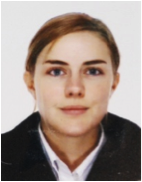 |
| Seconded from project partner |
RFR |
| Seconded to project partner |
Vienna University of Technology |
| Starting date |
2010-03-01 |
| Duration of secondment |
9 months |
| Short description |
Cold
bending of glass is achieved not only on monolithic glass panels, but
more often on laminated glass panels, consisting in two glass sheets
joined by a viscoelastic organic interlayer (most often polyvinyle
butyrale). The behavior of laminated glass noticeably varies from that
of monolithic glass, depending on the level of binding provided by the
interlayer. This task consists in a research on laminated glass cold bending. The aim of this task is the numerical modeling of laminated glass cold bending to refine the so called “stress factor” defined by the bind of glass sheets by the interlayer. This modeling based on viscoelastic theory sets up a numerical evaluation of short term and long term performance of cold bent glass. |
| Name of seconded researcher |
Simon FLÖRY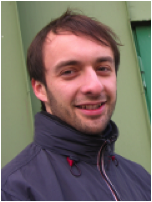 |
| Seconded from project partner |
Vienna University of Technology |
| Seconded to project partner |
RFR |
| Starting date |
2010-04-01 |
| Duration of secondment |
8 months |
| Short description |
The work of
the secondment focused on improvements to the computational framework
for the approximation and design with ruled surfaces and beyond. The
existing computational framework showed various limitations (with
regard to scalability, generalizability, license restrictions of
software dependences) that we sought to overcome in the course of this
secondment. Specific aims included a general optimization framework for
non-linear constrained optimization (not restricted to ruled / D-Strip
models), replacement of software dependencies with too restrictive
licenses by open source equivalents and feasibility studies of an
integration of existing software modules into third party tools (such
as Rhino). |
| Name of seconded researcher |
Alexander SCHIFTNER |
| Seconded from project partner |
Vienna University of Technology |
| Seconded to project partner |
Evolute |
| Starting date |
2010-10-01 |
| Duration of secondment |
12 months |
| Short description |
The main
goal of this secondment was the development of an easy to use tool for
design and approximation with developable strips and developable strip
models. The existing computational framework for developable strip
models, being part of a C++ library independent of a graphical user
interface, was given a graphical user interface by means of a plugin to
the 3D modeling software Rhinoceros3D. The resulting plugin, called EvoluteTools,
gives access to a wide range of results achieved within the research
project, and is available for academic use via the academic software
support initiative Evolute.Link. |
| Name of seconded researcher |
Mathias HÖBINGER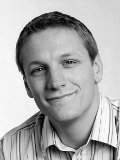 |
| Seconded from project partner |
Vienna University of Technology |
| Seconded to project partner |
RFR |
| Starting date |
2011-02-01 |
| Duration of secondment |
8 months |
| Short description |
This
secondment began few months after the initial launch of EvoluteTools, a
plugin to 3D modeling software Rhinoceros3D which was developed as a
tool for design and approximation of developable strip models based on
the existing computational framework for such models. Exposing this
technology to a much wider user base led to the discovery of some small
issues with the optimization code in relation to dense strip models
created by subdivision, so it became a target of this secondment to fix
these problems mainly by making the various optimization target
functions „strip-aware“, allowing them to adjust their behavior to the
very thin, elongated quads occuring in a strip model. The largest
effort during this secondment was, however, the creation of a scripting
interface for the EvoluteTools plugin. It was given an interface to the
powerful and widely used scripting language Visual Basic Script,
enabling efficient automatization of the plugins functionality, and
therefore making it a more powerful tool for use in the project. In addition, the plugin was presented to a diverse academic audience in several workshops, one of which resulted in the production of a seating area made up entirely of developable strips. |
| Name of seconded researcher |
Philippe BOMPAS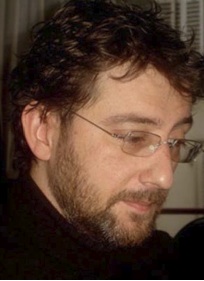 |
| Seconded from project partner |
RFR |
| Seconded to project partner |
Vienna University of Technology |
| Starting date |
2011-07-01 |
| Duration of secondment |
2.25 months |
| Short description |
The
secondment goal was to supervise of the tasks 10 of WP5 and WP7 and
their consistency as part of a global project. The involvement
particularly concerns support for the building envelop conception for
complex geometry for task 10 of WP5, support for forming technology and
potential technology from and to other fields of the industry , as well
as information gathering for future publications. The secondment was also dues to run exchange session with TUW, Evolute and the RFR seconded people in Vienna in order to enhance communication and knowledge transfer. The secondment includes the organization of the symposium Advances in Architectural Geometry 2012 in Paris. |
| Name of seconded researcher |
Olivier BERNARD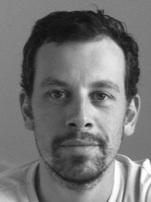 |
| Seconded from project partner |
RFR |
| Seconded to project partner |
Vienna University of Technology |
| Starting date |
2011-08-01 |
| Duration of secondment |
2.5 months |
| Short description |
Glass
panels present high strength under compression and in-plane shear.
However, the use of glass as shear bracing had been very limited
because of its brittleness. It’s only after 2000 that experimental
studies on glass shear walls started to appear. In Europe and in the
U.S., this is related to an architectural trend of all transparent
glass pavilions. Load bearing capacity of glass columns and panels,
including in-plane shear resistance, is studied. In Japan, glass panels
are expected to improve earthquake resistance of timber houses. Shear
resistance and damping effect under cyclic horizontal load are the
major topics. Curiously, glass panels treated in these researches are all flat, except those having very slight curvature due to fabrication error and wind pressure. The test results indicate that slightly curved panel is less resistant than flat panels. It is however possible, within a certain limit, to use curved panels as shear bracing. The present WP5 Task07 clarifies the behavior of rectangular cylindrical panels and determines the possible range of their use as shear bracing. The obtained knowledge will be hopefully applied to real construction, especially to realize glazed grid shell structures without any steel bracing. |
| Name of seconded researcher |
Nicolas LEDUC |
| Seconded from project partner |
RFR |
| Seconded to project partner |
Vienna University of Technology |
| Starting date |
2011-09-01 |
| Duration of secondment |
3 months |
| Short description |
The global
goal of this secondment is to cross the geometrical possibilities
derived from the semi-discretization of a double-curved surface into
d-strips and the manufacturing processes of the support structure. This
study is framed on a specific kind of roofing: glass grid shell. The different components of the structure (structural members and connecting nodes) will be subject to the research process. At an initial stage, an overview of the state of the art for the production methodology of structural members as well as the node design will be developed. Then, specific design and manufacturing technologies will be developed to fit the frame of the IAPP program and the studies carried out within the other tasks. 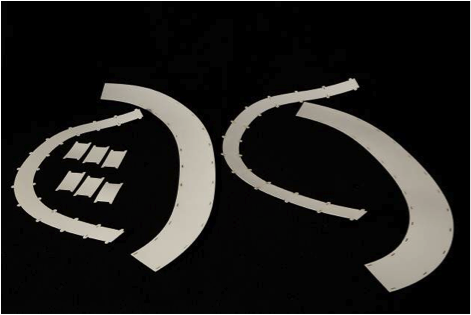 Developable box beam unfolded. 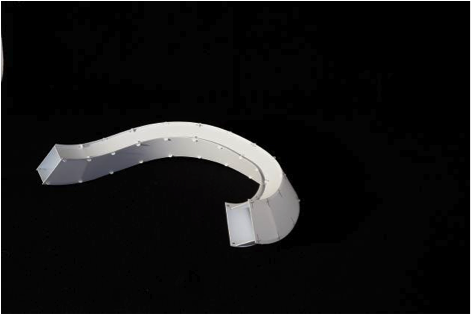 Developable box beam assembled. |
| Name of seconded researcher |
Akio SASSA |
| Seconded from project partner |
RFR |
| Seconded to project partner |
Vienna University of Technology |
| Starting date |
2011-10-01 |
| Duration of secondment |
3 months |
| Short description |
The aim of
this secondment was to understand the current technical limits and
constraints of curved glazing, which are related to fabrication
technology, particular structural behavior, complexity of fixing, etc.
This secondment treated in detail the following topics: 1) Various glass bending methods 2) Glass as structural element, especially as shear bracing 3) Glass-structure interface detailing, i.e., glass fixing and waterproofing The obtained information is classified in such a manner that it serves as basis for other tasks and that it facilitates detailing design of complex facetted and curved glazing. 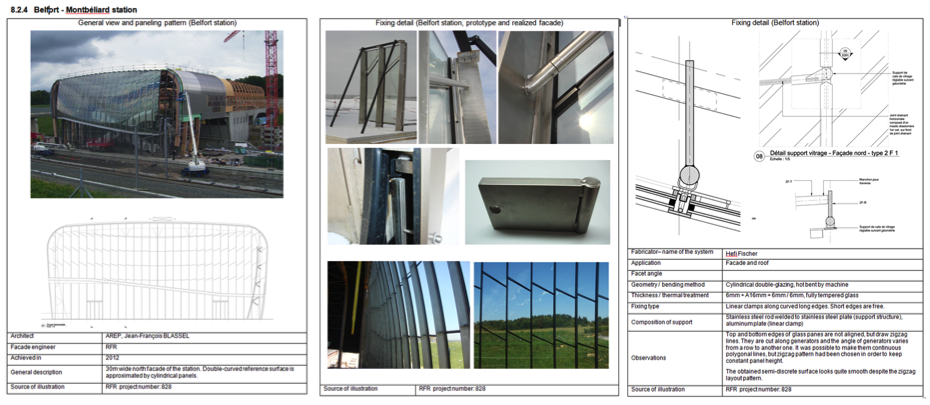 |
| Name of seconded researcher |
Alexander SCHIFTNER |
| Seconded from project partner |
Vienna University of Technology |
| Seconded to project partner |
RFR |
| Starting date |
2012-01-01 |
| Duration of secondment |
10 months |
| Short description |
The main
goal of this secondment was to create a user interface for the
computational framework for design and approximation including
manufacturing constraints, which had been developed previously. This
interface was created by means of a plugin to Rhinoceros 3D, allowing
comfortable and extensive control of the features of the computational
framework. Further goals included support of the organization of the
Advances in Architectural Geometry 2012 conference, as well as the
publication of project results through that conference.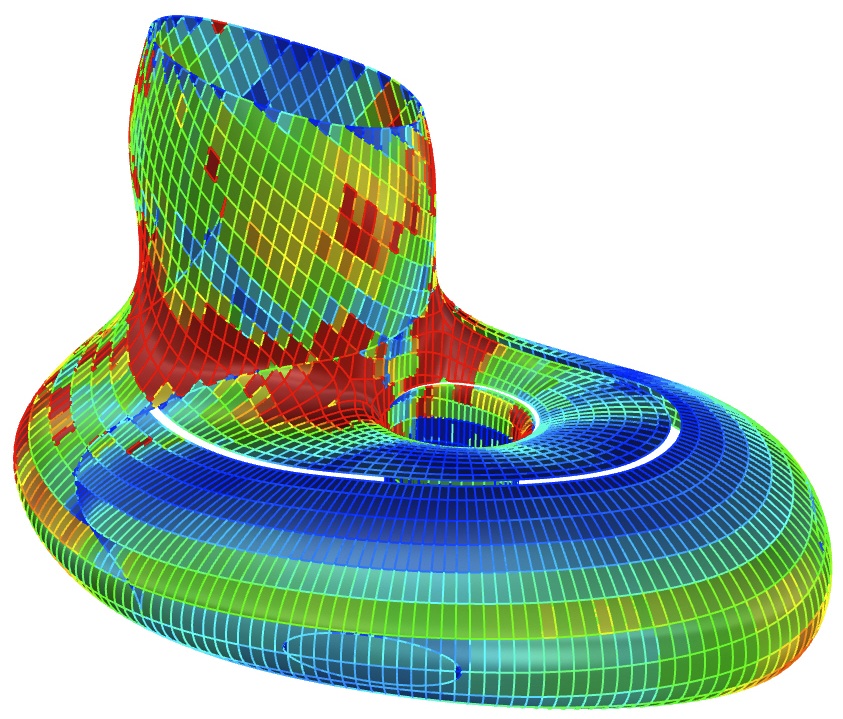 Screenshot of a 3D model of the façade of the Cite de Civilisations du Vin in Bordeaux, approximated using the plugin for design and approximation including manufacturing constraints. The rainbow color coding shows approximation errors. |
| Name of seconded researcher |
Omar ABDERRAZIK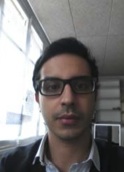 |
| Seconded from project partner |
RFR |
| Seconded to project partner |
Vienna University of Technology |
| Starting date |
2012-01-01 |
| Duration of secondment |
3 months |
| Short description |
The goal of this task is to combine both the geometrical and the structural optimization of a specific kind of structures: glass grid shell. The structural optimization of this kind of geometries is led using form-finding method of funicular geometries, which are double-curved. The geometrical optimization of this kind of structures is based on the semi-discretization into planar quads and D-strips. Those two methods are led consecutively, in a scripted dialogue, until convergence towards structures that are geometrically and structurally efficient. This study discusses the way to combine them, after presenting them briefly, and exposes in an example the result of this investigation. |
| Name of seconded researcher |
Martin KILIAN |
| Seconded from project partner |
Vienna University of Technology |
| Seconded to project partner |
Evolute |
| Starting date |
2012-02-01 |
| Duration of secondment |
5 months |
| Short description |
The aim of
this secondment was the study of special single curved panels and the
design and integration of corresponding prototype classes into the
existing C++ paneling framework of Evolute. In particular a robust and
versatile representation for circular cylinders and a subset of ruled
surfaces that are representable as graphs of low degree polynomials
have been investigated. Prototypical implementations have been tested
on data from real architectural projects. |
| Name of seconded researcher |
Simon FLÖRY |
| Seconded from project partner |
Vienna University of Technology |
| Seconded to project partner |
Evolute |
| Starting date |
2012-02-01 |
| Duration of secondment |
3 months |
| Short description |
After
design and implementation of a computational framework for constrained
non-linear optmization in my first secondment within the ARC project in
2010, the aims of my second secondment were to set this framework into
action. As application scenario we choose to tackle the ruled surface
reconstruction problem with special emphasis on conoidal ruled
surfaces. As with any non-linear optimization task, the problem at hand
required careful initialization and subsquent optimization, that will
be casted in the requirements of the first secondment's computational
framework. The results of the secondment were published at Advances in
Architectural Geometry 2012, paper Ruled
Free Forms. |
| Name of seconded researcher |
Mathias HÖBINGER |
| Seconded from project partner |
Vienna University of Technology |
| Seconded to project partner |
Evolute |
| Starting date |
2012-03-01 |
| Duration of secondment |
8 months |
| Short description |
The main
goals of this secondment were twofold. First, an important part of the
secondee’s work was to continue the development of EvoluteTools, the
plugin to the 3D modeling software Rhinoceros3D which is being
developed as a graphical user interface for the existing computational
framework for developable strip models. Secondly, the secondee
collaborated in research which led to the development of new methods
for efficiently approximating freeform shapes by self-supporting ones
using the concept of thrust networks from analysis. Amongst other
results, this research, which was presented at the SIGGRAPH 2012
conference, allows remeshing such shapes by self-supporting quad meshes
with planar faces.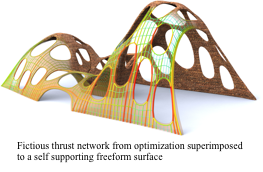 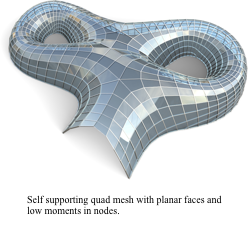 |
| Name of seconded researcher |
Helmut POTTMANN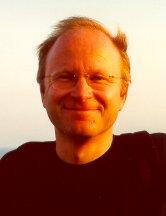 |
| Seconded from project partner |
Vienna University of Technology |
| Seconded to project partner |
RFR |
| Starting date |
2012-07-01 |
| Duration of secondment |
1 month |
| Short description |
The
secondment had 3 major goals: (i) Support RFR in the preparation of the
conference Advances in Architectural Geometry (ii) ARC management and
project review (iii) present our research on self-supporting surfaces
and discuss how it could be even better employed in the context of the
ARC project. |
| Name of seconded researcher |
Clement DUROSELLE |
| Seconded from project partner |
RFR |
| Seconded to project partner |
Vienna University of Technology |
| Starting date |
2012-09-01 |
| Duration of secondment |
2.5 months |
| Short description |
The global
goal of WP07 is to apply geometrical tools developed in other Working
Packages, notably in WP01, 02, 03 and 04, to industrial fields others
than architecture. The fabrication of complex double-curved surfaces
being a very difficult part in shipbuilding, we have chosen it as our
field of research. The present WP07 is focused on various vessel hulls
and especially on bulbous bows, which present particular difficulty of
fabrication. At the initial stage, an overview of architectural projects reflecting technological transfers from shipbuilding was provided. We have also listed up industrial fields to which our geometrical tools can be applied, and have made an inventory of the state of naval fabrication technology. As a case study, we applied semi-discretization tool to a double-curved bulbous bow. The smoothness of D-strip approximation was verified not only on 3D model, but also on a physical wooden model. 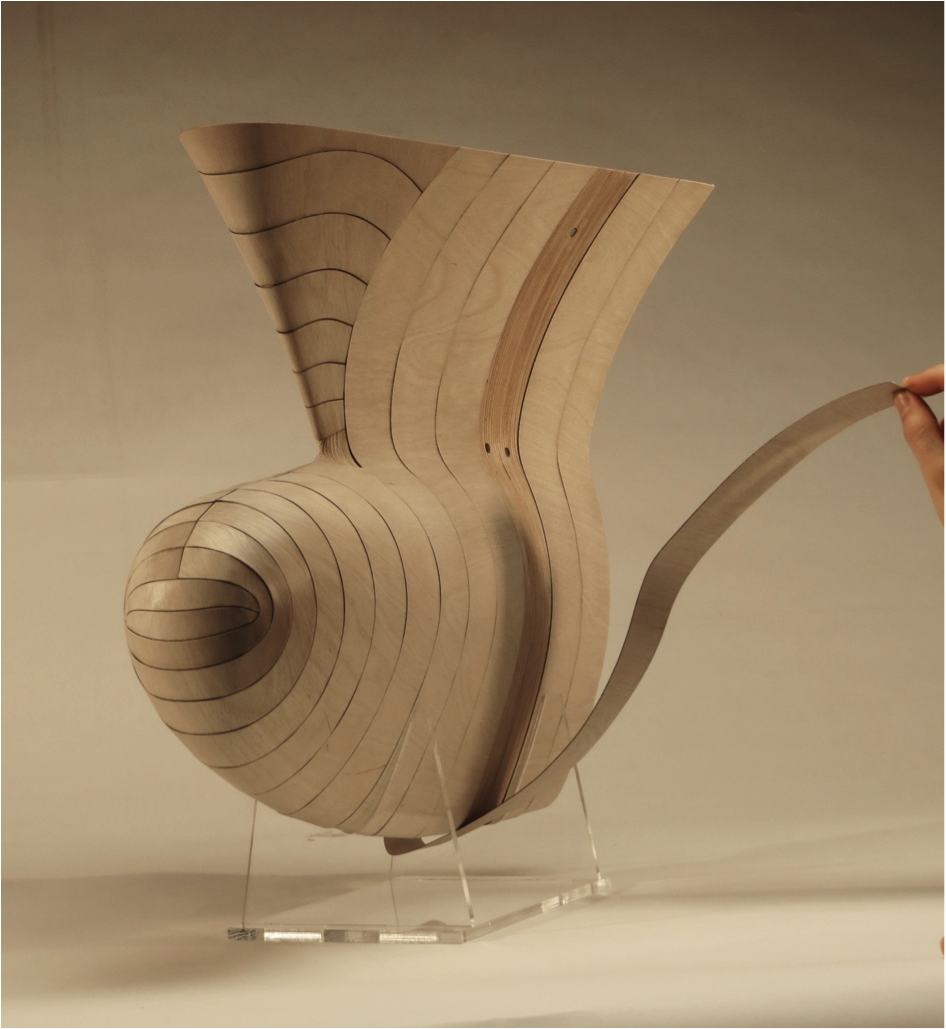 |
| Name of seconded researcher |
Alia Ben Ammar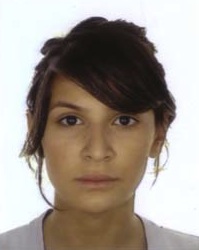 |
| Seconded from project partner |
RFR |
| Seconded to project partner |
Vienna University of Technology |
| Starting date |
2012-10-01 |
| Duration of secondment |
2 months |
| Short description |
This task
has two main goals: First of all, to establish a referential of
material other than glass that can be cold bent and suitable to produce
D-Strip , based on the findings of Task 02 by Raphael Royer De
Vericourt : Elastic deformation of simple shape to D-strip
approximation. Secondly it considers some typical opaque skin system to see where these materials could be used in these systems in a the form of the typology and analysis of potential application of the research. |
| Name of seconded researcher |
Akio SASSA |
| Seconded from project partner |
RFR |
| Seconded to project partner |
Vienna University of Technology |
| Starting date |
2012-10-17 |
| Duration of secondment |
3 months |
| Short description |
Glass
panels present high strength under compression and in-plane shear.
However, the use of glass as shear bracing had been very limited
because of its brittleness. It’s only after 2000 that experimental
studies on glass shear walls started to appear. In Europe and in the
U.S., this is related to an architectural trend of all transparent
glass pavilions. Load bearing capacity of glass columns and panels,
including in-plane shear resistance, is studied. In Japan, glass panels
are expected to improve earthquake resistance of timber houses. Shear
resistance and damping effect under cyclic horizontal load are the
major topics. Curiously, glass panels treated in these researches are all flat, except those having very slight curvature due to fabrication error and wind pressure. The test results indicate that slightlycurved panel is less resistant than flat panels. It is however possible, within a certain limit, to use curved panels as shear bracing. The present WP5 Task07 clarifies the behavior of rectangular cylindrical panels and determines the possible range of their use as shear bracing. The obtained knowledge will be hopefully applied to real construction, especially to realize glazed grid shell structures without any steel bracing. |
| Name of seconded researcher |
Mathias HÖBINGER |
| Seconded from project partner |
Vienna University of Technology |
| Seconded to project partner |
RFR |
| Starting date |
2012-12-01 |
| Duration of secondment |
3 months |
| Short description |
This
secondment during the final three months of the ARC projects duration
was used primarily to communicate results and changes in the
EvoluteTools plugin to researchers at the hosting project partner,
train these colleagues in its use and acquire feedback on its quality
from them. This final feedback was incorporated into a plan for the
further development of the software and in some instances led directly
to the implementation of small fixes or changes.The secondee was also
briefed by colleagues from RFR on their achievements within the ARC
project, and the secondment was marked by frequent discussions about
the various research and development results of the project, possible
use cases and opportunities for further collaboration. |
| Name of seconded researcher |
Frederick BINDJI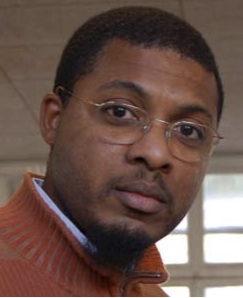 |
| Seconded from project partner |
RFR |
| Seconded to project partner |
Vienna University of Technology |
| Starting date |
2013-01-01 |
| Duration of secondment |
1 month |
| Short description |
Cold
bending of laminated glass has gained a lot of attention in the last
years, from researchers naturally enough but also from builders and
contractors. Standards need to assess the level of safety of the
product and to give rigorous methods to estimate stresses and
deflections in the laminated glass panel. This task consists in setting up and monitoring the tests on laminated glass cold bending with researchers at the University of Stuttgart. The aim of this task is the evaluation of accuracy of the numerical modeling while and to define each step for a reliable procedure to manufacture cold bent glass. This procedure encloses a way of measuring the true final geometry of the glass panel after noticeable relaxation has occurred. Residual stresses in the interlayer are also checked. |